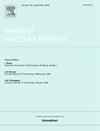高温对反应堆熔盐泵抗震性能及转子动力特性影响的研究
IF 2.3
3区 工程技术
Q1 NUCLEAR SCIENCE & TECHNOLOGY
引用次数: 0
摘要
高温熔盐泵是熔盐反应器和第一回路压力边界的关键旋转设备。该泵属于安全ⅰ类设备,属于地震ⅰ类设备。地震响应和转子动力学是泵稳定运行的关键,直接关系到整个反应堆的安全。熔盐泵的浸没温度高达700℃,明显高于压水堆一次冷却剂泵的设计温度。为了研究高温对熔盐泵抗震性能和转子动力特性的影响,本研究采用热-振动耦合数值模拟的方法,对比分析了有高温效应和无高温效应时熔盐泵的模态特性、地震响应和应力、转子临界转速和旋转幅值。分析结果表明,在高温作用下,熔盐泵的一阶模态频率降低了6.2%,模态振型变化不明显,地震作用下的位移和应力分别增加了13.9%和9.2%,转子的一阶临界转速降低了5.1%,旋转幅值增加了17.4%。高温对熔盐泵影响的主要因素是弹性模量的变化,热应力的影响相对较小。研究表明,在熔盐泵的地震和转子分析中,需要考虑高温的影响;否则,可能会造成特定的安全隐患。研究结果可为反应堆熔盐泵的设计和分析提供有价值的参考,进一步保证熔盐泵的稳定运行和结构完整。本文章由计算机程序翻译,如有差异,请以英文原文为准。
Study on the effect of high temperature on the seismic performance and rotor dynamic characteristics of the molten salt pump for reactor
The high-temperature molten salt pump is the crucial rotating equipment in the molten salt reactor and the first circuit’s pressure boundary. The pump belongs to safety class I equipment and seismic category I. Seismic response and rotor dynamics are essential for the stable operation of the pump, which is directly related to the entire reactor’s safety. The submerged temperature of the molten salt pump reaches as high as 700 °C, which is significantly higher than the design temperature of primary coolant pumps in pressurized water reactors. In order to investigate the effect of high temperature on the seismic performance and rotor dynamic characteristics of the molten salt pump, this study comparatively analyzed the modal characteristics, seismic response and stress, rotor critical speed, and rotational amplitude with the high-temperature effect and without high-temperature effect using thermal-vibration coupled numerical simulation. The analysis results showed that with the effect of high temperature, the molten salt pump’s first-order modal frequency has decreased by 6.2 %, the modal shape has not changed significantly, the displacement and stress under earthquake respectively have increased by 13.9 % and 9.2 %, the first-order critical speed of the rotor has decreased by 5.1 %, and the rotational amplitude has increased by 17.4 %. The primary factor of high temperature’s effect on the molten salt pump is the change of the elastic modulus, and the effect of the thermal stress is relatively minor. The research indicates that in the seismic and rotor analyses of molten salt pumps, the effect of high temperature needs to be considered; otherwise, it may cause specific safety hazards. The results of this paper can provide a valuable reference for the design and analysis of the molten salt pump for reactors and further ensure the pump’s stable operation and structural integrity.
求助全文
通过发布文献求助,成功后即可免费获取论文全文。
去求助
来源期刊

Annals of Nuclear Energy
工程技术-核科学技术
CiteScore
4.30
自引率
21.10%
发文量
632
审稿时长
7.3 months
期刊介绍:
Annals of Nuclear Energy provides an international medium for the communication of original research, ideas and developments in all areas of the field of nuclear energy science and technology. Its scope embraces nuclear fuel reserves, fuel cycles and cost, materials, processing, system and component technology (fission only), design and optimization, direct conversion of nuclear energy sources, environmental control, reactor physics, heat transfer and fluid dynamics, structural analysis, fuel management, future developments, nuclear fuel and safety, nuclear aerosol, neutron physics, computer technology (both software and hardware), risk assessment, radioactive waste disposal and reactor thermal hydraulics. Papers submitted to Annals need to demonstrate a clear link to nuclear power generation/nuclear engineering. Papers which deal with pure nuclear physics, pure health physics, imaging, or attenuation and shielding properties of concretes and various geological materials are not within the scope of the journal. Also, papers that deal with policy or economics are not within the scope of the journal.
 求助内容:
求助内容: 应助结果提醒方式:
应助结果提醒方式:


